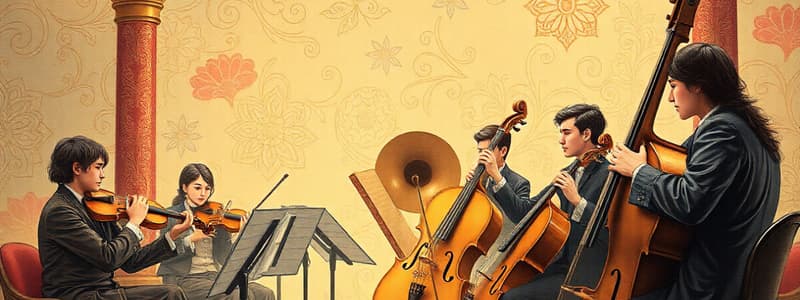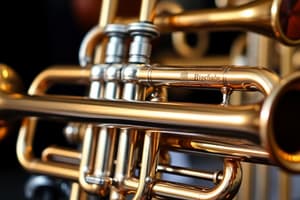Podcast
Questions and Answers
Which statement BEST describes the general arrangement of instruments in a symphony orchestra?
Which statement BEST describes the general arrangement of instruments in a symphony orchestra?
- Grouped by families and arranged by volume, with quieter instruments generally in front. (correct)
- Randomly positioned to create a diverse sound.
- Positioned based on the individual musician's preference.
- Arranged by height, from shortest to tallest.
Which of the following categories of instruments are NOT commonly found within the standard percussion section of an orchestra?
Which of the following categories of instruments are NOT commonly found within the standard percussion section of an orchestra?
- Instruments without fixed pitches
- Instruments with electronically generated sounds (e.g., synthesizers) (correct)
- Instruments tuned to specific notes (e.g., timpani)
- Instruments played by striking or shaking (e.g., xylophone)
How does the arrangement of instruments in a symphony orchestra affect its sound?
How does the arrangement of instruments in a symphony orchestra affect its sound?
- The arrangement produces an even balance between instruments from different sections.
- Random positioning allows the sound of the orchestra to shift and reverberate more.
- Instruments are arranged based both on family and volume from quieter to louder creating balance. (correct)
- The distance from the conductor affects instruments' ability to hear their cues.
Given the provided information, which brass instrument is likely positioned closest to the audience in a standard orchestral arrangement?
Given the provided information, which brass instrument is likely positioned closest to the audience in a standard orchestral arrangement?
Based on the information above which instrument sections in a standard symphony orchestra include a variety of instruments capable of producing markedly different tonal ranges from high to extremely low notes?
Based on the information above which instrument sections in a standard symphony orchestra include a variety of instruments capable of producing markedly different tonal ranges from high to extremely low notes?
What is a primary characteristic of percussion instruments? They produce sound by:
What is a primary characteristic of percussion instruments? They produce sound by:
If a new untuned percussion instrument were introduced to the orchestra, where would it MOST likely be placed?
If a new untuned percussion instrument were introduced to the orchestra, where would it MOST likely be placed?
What does the layout of an orchestra, having the conductor at the front, primarily facilitate?
What does the layout of an orchestra, having the conductor at the front, primarily facilitate?
Flashcards
Seating Arrangement
Seating Arrangement
Players are seated in a semicircle facing the conductor.
Balance of Sound
Balance of Sound
Louder instruments are behind quieter ones to blend sound.
Percussion Section
Percussion Section
Includes instruments producing sound by being struck or shaken.
Untuned Percussion
Untuned Percussion
Signup and view all the flashcards
Brass Instruments
Brass Instruments
Signup and view all the flashcards
Woodwind Section
Woodwind Section
Signup and view all the flashcards
Strings Section
Strings Section
Signup and view all the flashcards
Conductor
Conductor
Signup and view all the flashcards
Study Notes
Seating Arrangements
- Players are seated in a semicircle, facing the conductor
- Louder instruments are behind quieter instruments
- This creates a balance of sound
Percussion Section
- Percussion instruments produce sound by hitting or shaking them
- Some can be tuned to different notes, but most are untuned and have no fixed pitches
Brass Section
- Brass instruments are long metal tubes, coiled into various shapes
- Trumpets make the highest notes
- Horns and trombones sound the middle notes
- Tubas produce the lowest notes
Woodwind Section
- Woodwind instruments produce sound by vibrating air in a tube
- Instruments are in two rows
- Instruments range from the high-pitched piccolo to the low contra bassoon
Studying That Suits You
Use AI to generate personalized quizzes and flashcards to suit your learning preferences.





